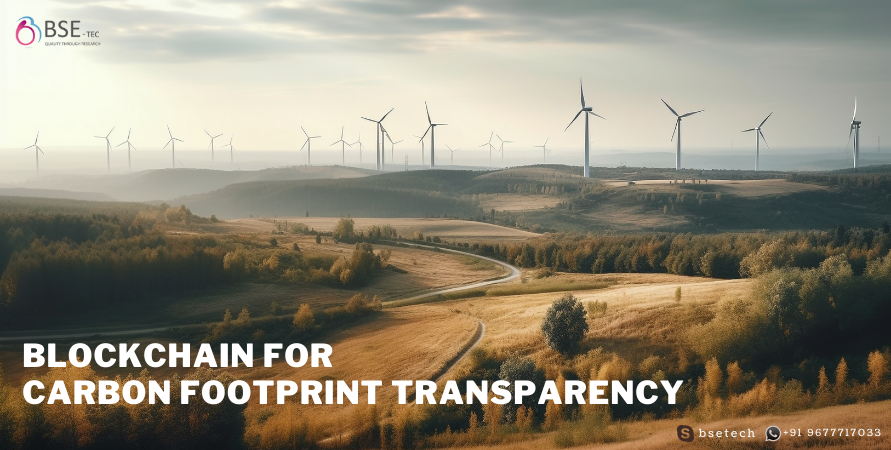Blockchain for Carbon footprint transparency

A footprint literally means the mark you leave on beach sand or something like that. Similarly, a corporate footprint relates to the impact an organization has on the environment. It can also be referred to as carbon footprint, environmental footprint,
What is Carbon Footprint?

Carbon footprint is the total amount of greenhouse gases emitted directly or indirectly by individuals, products, enterprises, or organizations. While the measurement actually accounts for the release of a number of different world-warming gases — like methane, nitrous oxide, and fluorinated gases — results are typically expressed in terms of carbon dioxide equivalency.
How is Carbon Footprint Calculated?

Steps Involved in Traditional Carbon Footprint Calculation
Calculating the carbon footprint involves quantifying the total greenhouse gas emissions generated by an individual, organization, or product. Carbon footprints are traditionally calculated in the following steps.
1. Scope Definition: Determine the scope of the carbon footprint calculation. This includes identifying the boundaries of emissions to be considered, such as direct emissions (Scope 1), indirect emissions from purchased electricity (Scope 2), and indirect emissions from the supply chain (Scope 3).
2. Data Collection: Gather data on energy consumption, transportation, waste generation and disposal, and other relevant activities. This may involve collecting utility bills, fuel consumption records, production data, travel logs, and supplier information.
3. Emission Factors: Use emission factors specific to each activity or energy source to convert the collected data into greenhouse gas emissions. Emission factors are standardized coefficients that estimate the emissions associated with a particular unit of activity or energy use.
4. Calculation: Multiply the activity or energy use data by the respective emission factors to calculate the emissions for each category (Scope 1, 2, and 3). Sum up these emissions to obtain the total carbon footprint.
5. Conversion: Convert the emissions of different greenhouse gases (such as carbon dioxide, methane, and nitrous oxide) into a common unit of measurement, usually carbon dioxide equivalent (CO2e). This conversion accounts for the varying global warming potentials of different gases.
6. Reporting: Present the calculated carbon footprint in a clear and understandable format, often including breakdowns by emission source, recommendations for reduction strategies, and comparisons to benchmarks or targets.
Limitations of Traditional Carbon Footprint Measurement
1. Lack of Transparency: Traditional carbon footprint measurement relies heavily on self-reported data, leading to potential inaccuracies or intentional misreporting. Verification of data can be challenging, making it difficult to ensure the integrity of the reported carbon footprint.
2. Data Silos: Data required for calculating carbon footprints is often scattered across multiple sources and systems. Integration and consolidation of this data can be time-consuming and error-prone, leading to inefficiencies and delays in reporting.
3. Limited Traceability: Tracking the journey of carbon emissions from their source to their final impact is complex using traditional methods. This lack of traceability makes it difficult to identify the most significant emission sources and implement effective reduction strategies.
Read Upwork Business Model: How Upwork Works & What Is Upwork Clone?
Blockchain-based Carbon Footprint Measurement
Blockchain technology offers a promising solution to the limitations of traditional carbon footprint measurement. Blockchain-based carbon footprinting has 4 stages, which are
- Immutable Data Collection with Smart IoT Devices
Generating and Collecting carbon emissions from various sources is readily available in real-time
- Data Cleaning and Filtration
Before storing the data in the blockchain, it goes through a series of data cleaning and filtration process where duplicate data are eliminated. It also goes through compliance measures to ensure data and personal data have the necessary security. Finally, before adding the data to the blockchain, meta information like the company’s name, addresses, and stakeholders are added to make the data more structured and efficient.
- Real-Time Reliable Data Processing to make informed decisions
When the data gets stored on the blockchain, the smart contracts will trigger to calculate the carbon footprints based on various factors. The CF report thus created is transparent and is available for all the stakeholders to access. Organizations like WWF, Siera Club, and others can also access the CF report due to blockchain’s transparency.
- Data Utilization
Using the carbon footprints report created by smart contracts, investors or important clients can choose with whom to do business and how much money to invest in it. The CF report can also be used in Carbon Trading, where the organization can sell their carbon credits to companies with low carbon credits.
Steps Involved in Blockchain-Based Carbon Footprinting Measurement
- An IoT-enabled smart meter (M1) that is connected to the diesel electricity generator must be installed first.
- The smart meter generates the reading after which it saves it immediately on the blockchain on a weekly, monthly, or yearly basis.
- The smart meter will trigger the smart contracts to calculate the CF report based on the following conditions.
- Generating style of electricity
- a local area’s conversion factor
- Total petrol usage of the company and meter efficacy (whether it is functioning well or not).
- Businesses will receive the Carbon Footprint figure automatically in mobile apps or web portals.
Benefits of using Blockchain-Based Carbon Footprinting Measurement
✔ Immutability
✔ Transparency
✔ Automation with Smart IoT devices
✔ Accurate and Real-time data
✔ Maximized ROI
✔ Carbon Trading with Carbon Credits.
What is the Best Carbon Footprint Calculator?
Determining the best carbon footprint calculator depends on various factors, including the purpose of measurement, the level of detail required, and the specific geographical context. Some of the best know CF Calculators are Carbon Trust Footprint Calculator, Global Footprint Network Calculator, and WWF Footprint Calculator. Individuals can access these calculators to know their carbon footprints.
How To Reduce Carbon Footprints?
Reducing carbon footprints is overwhelming and it requires more efficient planning at the industry level. But the Carbon footprint you contribute as an individual can be more helpful when everyone comes forward to reduce their CF level. Here are some tips to reduce carbon footprints as an individual.

- Use conservative Energy
- Reduce, reuse, recycle
- Save water
- Use Sustainable Transports
- Eat Sustainably from local markets
- Reduce Air Travel
- Plant Trees
- Say not to plastic
The advent of blockchain technology has introduced transformative changes in the field of carbon footprint measurement. By addressing the limitations of traditional methods, blockchain-based approaches offer enhanced transparency, accuracy, and traceability. The decentralized and immutable nature of the blockchain ensures trust and accountability, enabling more efficient and effective management of carbon emissions. As the world faces the urgent challenge of climate change, embracing blockchain-based carbon footprint measurement systems has the potential to accelerate our progress toward a sustainable future.
Get in touch with the team of blockchain experts at BSEtec to know how they can help you with a hassle-free carbon footprinting process while achieving your sustainability goals.
Did you find this article useful? Let us know by leaving a comment below, or join us on Twitter and Facebook.




